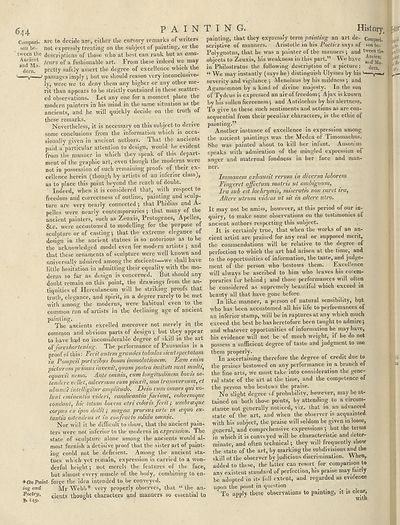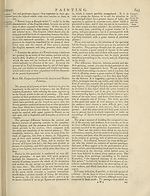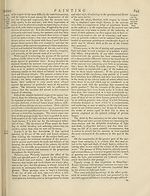Encyclopaedia Britannica > Volume 15, NIC-PAR
(720) Page 644
Download files
Complete book:
Individual page:
Thumbnail gallery: Grid view | List view

6u
Compari¬
son be¬
tween tbe
Ancient
and Mo¬
dem.
* On Paint
ing and
Poetry,
x49-
PAIN
are te decide are, eitliei* Uie cttfSftry remarks of writers
iiot expressly treating on the subject of painting, or the
descriptions of those who at best can rank but as ama¬
teurs of a fashionable art. From these indeed we may
pretty safely assert the degree ot excellence which the
passages imply } but we should reason very inconclusive¬
ly, were we to deny them any higher or any other me¬
rit than appears to be strictly contained in these scatter¬
ed observations. Let any one for a moment place the
modern painters in his mind in the same situation as the.
ancients, and he will quickly decide on the truth of
these remarks.
Nevertheless, it is necessary on this subject to derive
some conclusions from the information which is occa-
sionally given in ancient authors. Ihat the ancients
paid a particular attention to design, would be evident
from the manner in which they speak ol this depart¬
ment of the graphic art, even though the moderns were
not in possession of such remaining proofs of their ex¬
cellence herein (though by artists of an inferior class),
as to place this point beyond the reach of doubt.
Indeed, when it is considered that, with respect to
freedom and correctness of outline, painting and sculp¬
ture are very nearly connected ^ that I hidias and A-
peiles were nearly contemporaries ; that many of the
ancient painters, such as Zeuxis, Protogenes, Apelles,
&.c. were accustomed to modelling for the purpose of
sculpture or of casting', that the extreme elegance of
design in the ancient statues is so notorious as to be
the acknowledged model even for modern artists ; and
that these ornaments of sculpture were well known and
uniyersallv admired among the indents—we shall have
little hesitation in admitting their equality with the mo¬
derns so far as design is concerned. But should any
doubt remain on this point, the drawings from the an¬
tiquities of Herculaneum will be striking proofs that
truth, elegance, and spirit, in a degree rarely to be met
with among the moderns, were habitual even to the
common run of artists in the declining age of ancient
painting.
The ancients excelled moreover not merely in the
common and obvious parts of design j but they appear
to have had no inconsiderable degree of skill in the art
of foreshortening. The performance of Pausanias is a
proof of this: Fecit autem grandes tabulas sicut spectatam
in Pompeii porticibps bourn immolationcm. Earn enim
picturam primus invenit, quam postea imitati sunt multi,
equavit nemo. Ante omnia, cum longitudinem bovis os-
tendere vdlet, adversum eum.pin.xit, non transversum, et
abunde intelligitur ampliiudo. Dein cum omnes qui vo¬
lant eminentia videri, candicantia facuint, coloremque
condani, hie totum bovem atri color is fecit; umbra que
corpus ex ipso dedit; magna prorsus arte in a quo ex¬
tan Via ostendens et in confracto sohdu omnia.
Nor will it be difficult to show, that the ancient pain¬
ters were not inferior to the moderns in expression. The
state of sculpture alone among the ancients would al¬
most furnish a decisive proof that the sister art of paint¬
ing could not be deficient. Among the ancient sta¬
tues which yet remain, expression is carried to a tvon-
derful heightnot merely the features of the face,
but almost every muscle of the body, combining to en¬
force the idea intended to be conveyed.
Mr Webb* very properly observes, that “ the an¬
cients thought characters q.n<\ manners so essential to
TING. History,
painting, that they expressly term painting an art de- Compari.
scriptive of manners. Aristotle in his Poetics says of nm be-
Polygnotus, that he was a painter of the manners', and tween the
objects to Zeuxis, his weakness in this part.” We have
in Philostratus the following description of a picture : dern.
“ We may instantly (says he) distinguish Ulysses by his y
severity and vigilance } Menelaus by his mildness ', and
Agamemnon by a kind of divine majesty. In the son
of Tydeus is expressed an air of freedom j Ajax is known
by his sullen fierceness*, and Antilochus by his alertness.
To give to these such sentiments and actions as are con¬
sequential from their peculiar characters, is the ethic of
painting.”
Another instance of excellence in expression among
the ancient paintings was the Medea of Timomachus.
She was painted about to kill her infant. Ausomus
speaks with admiration of the mingled expression of
ano-er and maternal fondness in her face and man-
C
ner.
Immanem exhausit rerum in diversa laborem
Fingeret affectum matris ut ambiguum,
Ira sub est lachrymis, miseratio non caret ira,
Altere utrurn videus ut sit in altere utro.
It may not be amiss, however, at this period of our in¬
quiry, to make some observations on the testimonies of
ancient authors respecting this subject.
It is certainly true, that when the works of an an¬
cient artist are praised for any real or supposed merit,
the commendations will be relative to the degree of
perfection to which the art had arisen at the time, and
to the opportunities of information, the taste, and judge¬
ment of the person who bestows them. Excellence
will always he ascribed to him who leaves his cotem-
poraries far behind j and those performances will often
be considered as supremely beautiful which exceed in
beauty all that have gone before
In like manner, a person ot natural sensibility, bpt
who has been accustomed all his life to performances of
an inferior stamp, will be in raptures at any which much
exceed the best he has heretofore been taught to admire j
and whatever opportunities of information he may have,
his evidence will not be of much weight, if he do not
possess a sufficient degree of taste and judgment to use
them properly.
In ascertaining therefore the degree of credit due to
the praises bestowed on any performance in a blanch of
the fine arts, we must take into consideration the gene¬
ral state of the art at the time, and the competence of
the person who bestows the praise.
No slight degree of probability, however, may be at¬
tained on^ both those points, by attending to a circum¬
stance not generally noticed, viz. that in an advanced
state of the art, and when the observer is acquainted
with his subject, the praise will seldom be given in loose,
general, and comprehensive expressions j but the terms
m which it is conveyed will be characteristic and deter¬
minate, and often technical', they will frequently show
the state of the art, by marking the subdivisions and the
skill ot the observer by judicious discrimination. When,
added to these, the latter can resort for comparison to
anv existent standard of perfection, his praise may fairly
be'adopted in its full extent, and regarded as evidence
upon the point in question . • • i
' To aoplv these observations to painting, it is clear,
* ^ Tvitn
Compari¬
son be¬
tween tbe
Ancient
and Mo¬
dem.
* On Paint
ing and
Poetry,
x49-
PAIN
are te decide are, eitliei* Uie cttfSftry remarks of writers
iiot expressly treating on the subject of painting, or the
descriptions of those who at best can rank but as ama¬
teurs of a fashionable art. From these indeed we may
pretty safely assert the degree ot excellence which the
passages imply } but we should reason very inconclusive¬
ly, were we to deny them any higher or any other me¬
rit than appears to be strictly contained in these scatter¬
ed observations. Let any one for a moment place the
modern painters in his mind in the same situation as the.
ancients, and he will quickly decide on the truth of
these remarks.
Nevertheless, it is necessary on this subject to derive
some conclusions from the information which is occa-
sionally given in ancient authors. Ihat the ancients
paid a particular attention to design, would be evident
from the manner in which they speak ol this depart¬
ment of the graphic art, even though the moderns were
not in possession of such remaining proofs of their ex¬
cellence herein (though by artists of an inferior class),
as to place this point beyond the reach of doubt.
Indeed, when it is considered that, with respect to
freedom and correctness of outline, painting and sculp¬
ture are very nearly connected ^ that I hidias and A-
peiles were nearly contemporaries ; that many of the
ancient painters, such as Zeuxis, Protogenes, Apelles,
&.c. were accustomed to modelling for the purpose of
sculpture or of casting', that the extreme elegance of
design in the ancient statues is so notorious as to be
the acknowledged model even for modern artists ; and
that these ornaments of sculpture were well known and
uniyersallv admired among the indents—we shall have
little hesitation in admitting their equality with the mo¬
derns so far as design is concerned. But should any
doubt remain on this point, the drawings from the an¬
tiquities of Herculaneum will be striking proofs that
truth, elegance, and spirit, in a degree rarely to be met
with among the moderns, were habitual even to the
common run of artists in the declining age of ancient
painting.
The ancients excelled moreover not merely in the
common and obvious parts of design j but they appear
to have had no inconsiderable degree of skill in the art
of foreshortening. The performance of Pausanias is a
proof of this: Fecit autem grandes tabulas sicut spectatam
in Pompeii porticibps bourn immolationcm. Earn enim
picturam primus invenit, quam postea imitati sunt multi,
equavit nemo. Ante omnia, cum longitudinem bovis os-
tendere vdlet, adversum eum.pin.xit, non transversum, et
abunde intelligitur ampliiudo. Dein cum omnes qui vo¬
lant eminentia videri, candicantia facuint, coloremque
condani, hie totum bovem atri color is fecit; umbra que
corpus ex ipso dedit; magna prorsus arte in a quo ex¬
tan Via ostendens et in confracto sohdu omnia.
Nor will it be difficult to show, that the ancient pain¬
ters were not inferior to the moderns in expression. The
state of sculpture alone among the ancients would al¬
most furnish a decisive proof that the sister art of paint¬
ing could not be deficient. Among the ancient sta¬
tues which yet remain, expression is carried to a tvon-
derful heightnot merely the features of the face,
but almost every muscle of the body, combining to en¬
force the idea intended to be conveyed.
Mr Webb* very properly observes, that “ the an¬
cients thought characters q.n<\ manners so essential to
TING. History,
painting, that they expressly term painting an art de- Compari.
scriptive of manners. Aristotle in his Poetics says of nm be-
Polygnotus, that he was a painter of the manners', and tween the
objects to Zeuxis, his weakness in this part.” We have
in Philostratus the following description of a picture : dern.
“ We may instantly (says he) distinguish Ulysses by his y
severity and vigilance } Menelaus by his mildness ', and
Agamemnon by a kind of divine majesty. In the son
of Tydeus is expressed an air of freedom j Ajax is known
by his sullen fierceness*, and Antilochus by his alertness.
To give to these such sentiments and actions as are con¬
sequential from their peculiar characters, is the ethic of
painting.”
Another instance of excellence in expression among
the ancient paintings was the Medea of Timomachus.
She was painted about to kill her infant. Ausomus
speaks with admiration of the mingled expression of
ano-er and maternal fondness in her face and man-
C
ner.
Immanem exhausit rerum in diversa laborem
Fingeret affectum matris ut ambiguum,
Ira sub est lachrymis, miseratio non caret ira,
Altere utrurn videus ut sit in altere utro.
It may not be amiss, however, at this period of our in¬
quiry, to make some observations on the testimonies of
ancient authors respecting this subject.
It is certainly true, that when the works of an an¬
cient artist are praised for any real or supposed merit,
the commendations will be relative to the degree of
perfection to which the art had arisen at the time, and
to the opportunities of information, the taste, and judge¬
ment of the person who bestows them. Excellence
will always he ascribed to him who leaves his cotem-
poraries far behind j and those performances will often
be considered as supremely beautiful which exceed in
beauty all that have gone before
In like manner, a person ot natural sensibility, bpt
who has been accustomed all his life to performances of
an inferior stamp, will be in raptures at any which much
exceed the best he has heretofore been taught to admire j
and whatever opportunities of information he may have,
his evidence will not be of much weight, if he do not
possess a sufficient degree of taste and judgment to use
them properly.
In ascertaining therefore the degree of credit due to
the praises bestowed on any performance in a blanch of
the fine arts, we must take into consideration the gene¬
ral state of the art at the time, and the competence of
the person who bestows the praise.
No slight degree of probability, however, may be at¬
tained on^ both those points, by attending to a circum¬
stance not generally noticed, viz. that in an advanced
state of the art, and when the observer is acquainted
with his subject, the praise will seldom be given in loose,
general, and comprehensive expressions j but the terms
m which it is conveyed will be characteristic and deter¬
minate, and often technical', they will frequently show
the state of the art, by marking the subdivisions and the
skill ot the observer by judicious discrimination. When,
added to these, the latter can resort for comparison to
anv existent standard of perfection, his praise may fairly
be'adopted in its full extent, and regarded as evidence
upon the point in question . • • i
' To aoplv these observations to painting, it is clear,
* ^ Tvitn
Set display mode to:
![]() Universal Viewer |
Universal Viewer | ![]() Mirador |
Large image | Transcription
Mirador |
Large image | Transcription
Images and transcriptions on this page, including medium image downloads, may be used under the Creative Commons Attribution 4.0 International Licence unless otherwise stated. ![]()
| Encyclopaedia Britannica > Encyclopaedia Britannica > Volume 15, NIC-PAR > (720) Page 644 |
|---|
| Permanent URL | https://digital.nls.uk/192591058 |
|---|
| Attribution and copyright: |
|
|---|
| Shelfmark | EB.11 |
|---|---|
| Description | Ten editions of 'Encyclopaedia Britannica', issued from 1768-1903, in 231 volumes. Originally issued in 100 weekly parts (3 volumes) between 1768 and 1771 by publishers: Colin Macfarquhar and Andrew Bell (Edinburgh); editor: William Smellie: engraver: Andrew Bell. Expanded editions in the 19th century featured more volumes and contributions from leading experts in their fields. Managed and published in Edinburgh up to the 9th edition (25 volumes, from 1875-1889); the 10th edition (1902-1903) re-issued the 9th edition, with 11 supplementary volumes. |
|---|---|
| Additional NLS resources: |
|

